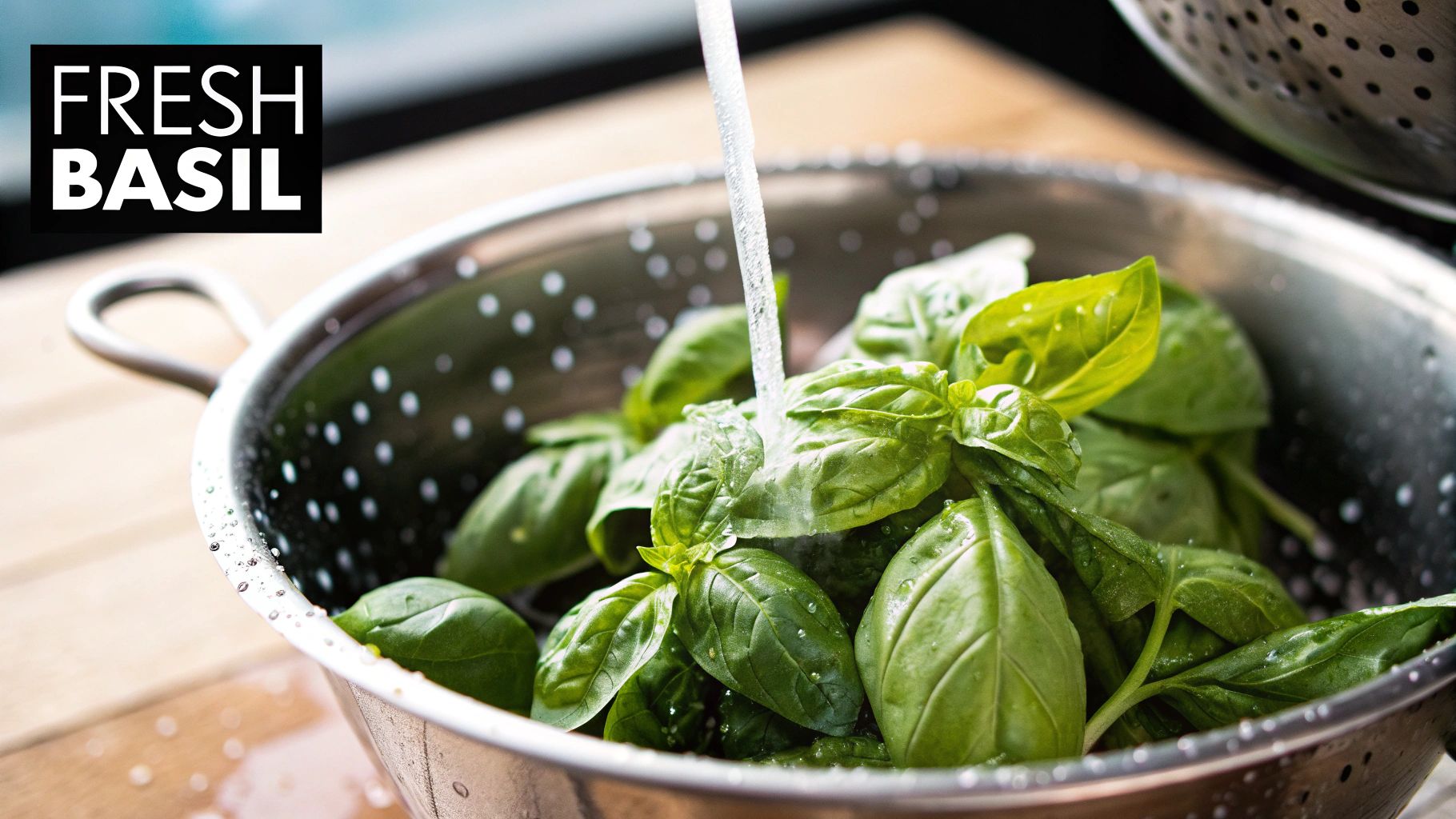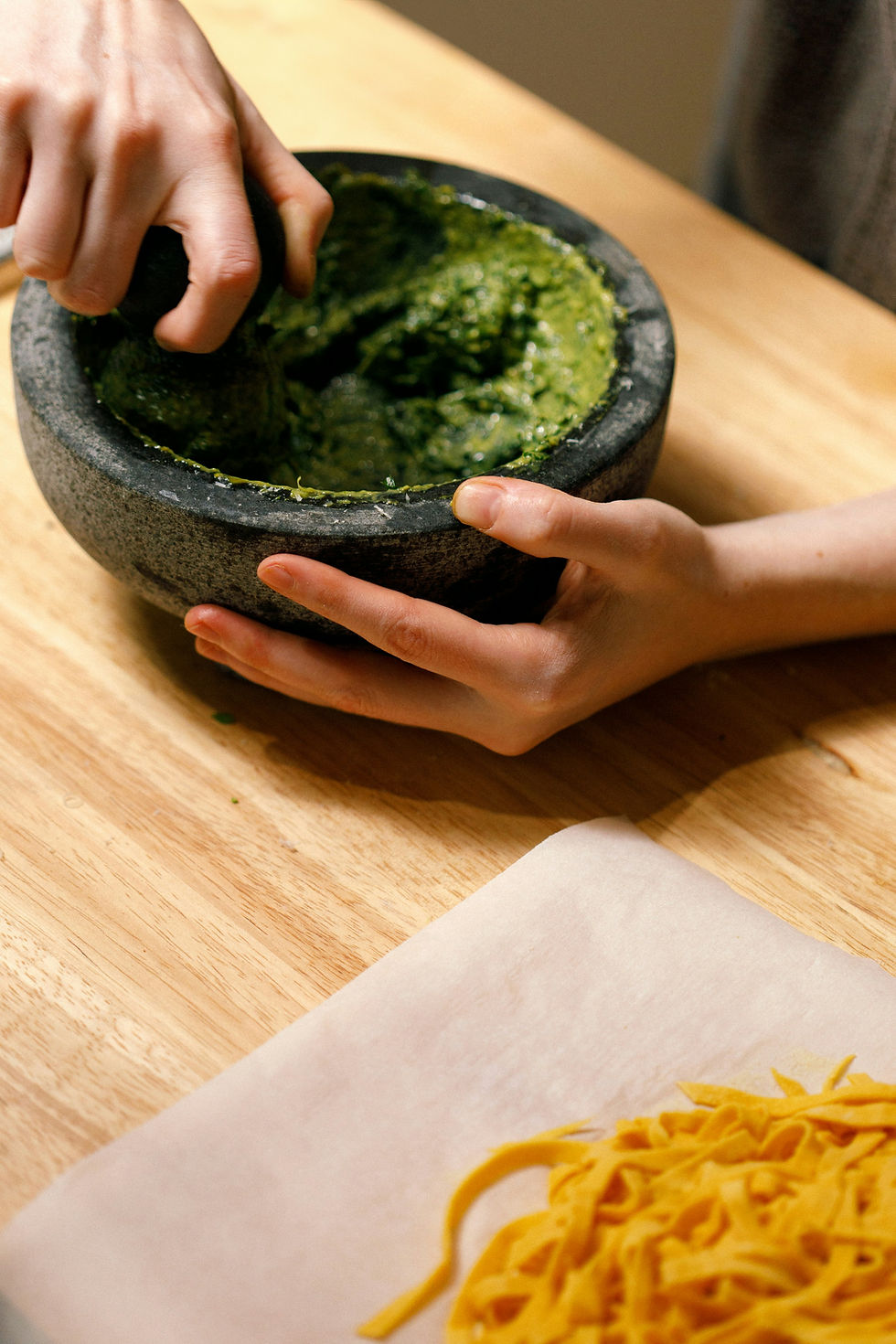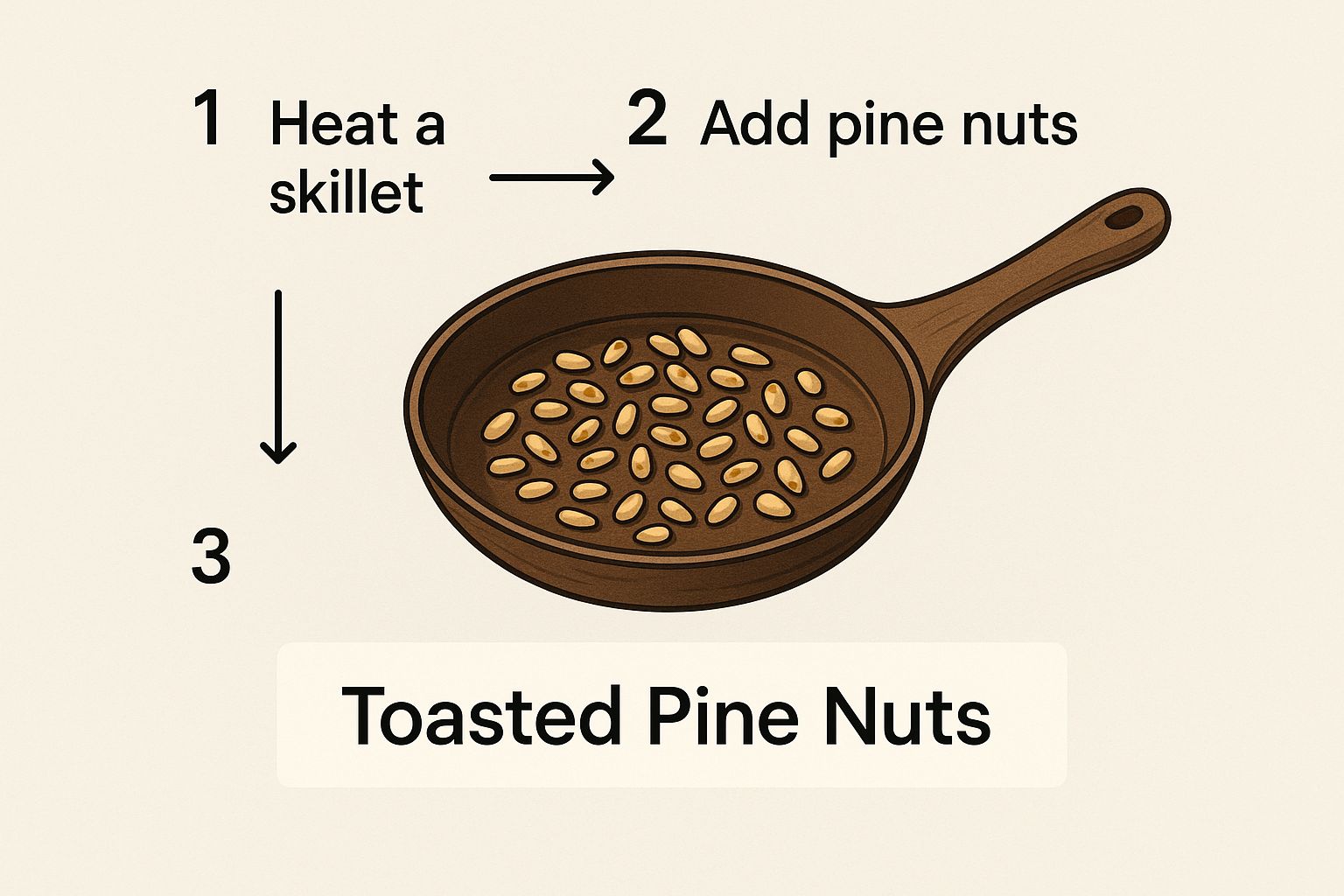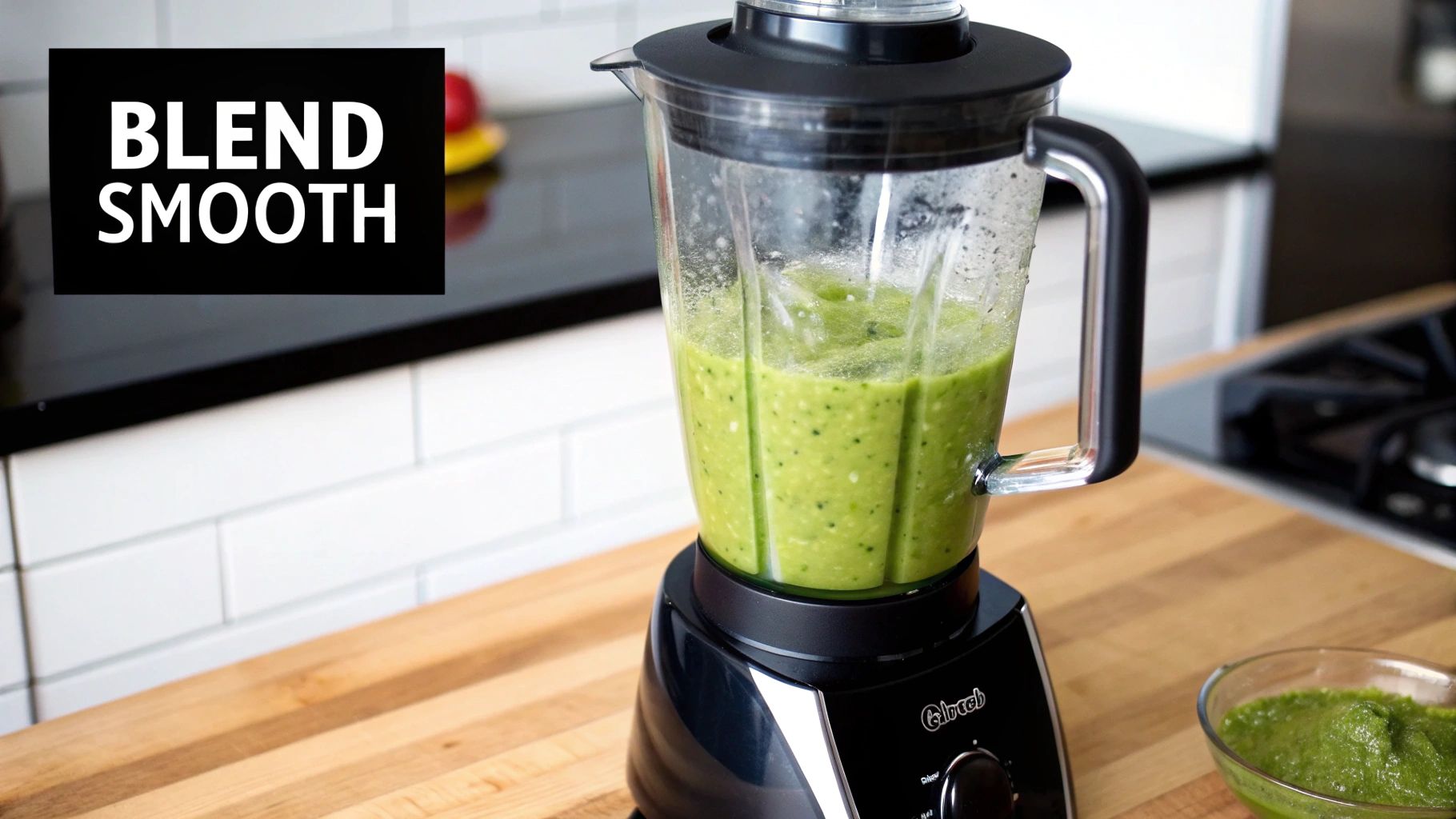How to Make Pesto Sauce The Right Way
- IFM GOURMET RETAIL
- Aug 18
- 13 min read
Updated: Aug 22
At its heart, making pesto is about a kind of alchemy—turning five simple things like basil, pine nuts, garlic, cheese, and olive oil into something truly magical. The real secret is in the process, crushing everything together to release all those incredible oils and flavors until you get a rich, vibrant sauce.
The Soul of Pesto: Crafting the Perfect Italian Sauce
Before you even reach for a food processor or a mortar and pestle, it's worth taking a moment to appreciate what makes pesto, well, pesto. This is more than just a recipe; it's a deep dive into a classic of Italian cuisine called Pesto alla Genovese. Coming from Genoa, the capital of Liguria, this sauce is a true cultural icon, celebrating freshness and beautiful simplicity.
The magic is all in the balance. Every single ingredient has a job to do, and the quality you choose makes all the difference in the final taste. Especially in a cosmopolitan city like Dubai, where everyone appreciates authentic flavors, understanding the "why" behind each ingredient is your first step to making something amazing. It's how a simple sauce becomes a gourmet experience.
Why Quality Ingredients Are Everything
I can't stress this enough: using premium ingredients isn't just a nice-to-have, it's the entire philosophy behind truly great pesto. The gap between a decent sauce and a totally unforgettable one is all about sourcing the best you can find. For example, using real Parmigiano-Reggiano instead of a generic hard cheese gives you a nutty, salty depth you just can't fake.
Pesto is the ultimate expression of fresh ingredients working together. It doesn’t hide behind complicated cooking techniques—its beauty is in its purity. That’s why sourcing from a trusted supplier like IFM Gourmet Dubai, known for its quality, authenticity, and culinary elegance, can take your homemade sauce from good to genuinely exceptional.
Pesto's Growing Popularity in the UAE
The love for real Italian food has taken over the globe, and the UAE is definitely part of that story. Pesto has become incredibly popular here, showing up in more and more retail stores and on restaurant menus. This trend is all about a growing appreciation for bright Mediterranean flavors and authentic dining.
In fact, market analysts are projecting that the global market for pesto-based pasta sauces will grow at a rate of around 8.9% between 2021 and 2028, with a huge part of that demand coming from hotels and catering. If you're curious, you can learn more about these market trends and explore the full research.
Choosing Your Ingredients: The Foundation of Flavor
The real secret to an unforgettable pesto isn't some complicated, cheffy technique—it all comes down to the quality of your ingredients. This is where the magic happens. Building the perfect pesto starts with sourcing components that are bursting with freshness and character.
Think of it like assembling an all-star team; every single player has a vital role. From the peppery zing of the basil to the rich depth of the cheese, the final sauce is a direct reflection of what you put into it. For those with a discerning palate here in Dubai, sourcing from a purveyor of fine foods like IFM Gourmet Dubai ensures every ingredient is top-notch, leading to a truly authentic experience. As the luxury online gourmet arm of IFM Investments LLC, they offer an impressive lineup of artisanal delicacies that can elevate any recipe.
Selecting the Perfect Basil
Basil is the heart and soul of any classic pesto. Period. Traditionally, Pesto alla Genovese demands small-leaf Genovese basil, which is prized for its delicate, almost sweet aroma that lacks the minty notes you find in other common types.
When you're at the market, look for leaves that are a vibrant, healthy green. They should be firm, not limp or wilted. If you see any dark spots or yellowing, steer clear—that basil is past its prime. Starting with the best, like these Sweet Italian Large Leaf heirloom basil seeds, lays the groundwork for an incredible pesto.
To help you get the best of the best, here's a quick guide to selecting the core components for your pesto.
Ingredient | What to Look For | Flavor Contribution |
|---|---|---|
Fresh Basil | Vibrant green, unwilted leaves with no dark spots. Genovese variety is ideal. | Sweet, peppery, and aromatic base of the sauce. |
Pine Nuts | Plump, pale, and fresh-smelling. Avoid any that look shriveled or oily. | Creamy texture and a rich, buttery, nutty flavor. |
Parmigiano-Reggiano | A wedge with the "pin-dot" rind. Avoid pre-grated options. | Salty, sharp, and complex umami depth. |
Extra Virgin Olive Oil | A good quality, cold-pressed oil with a fruity, smooth flavor. | Binds the sauce and adds a smooth, luxurious mouthfeel. |
Garlic | Firm, heavy bulbs with tight, unbroken skin. No soft spots or green sprouts. | A pungent, aromatic warmth that elevates the other flavors. |
Paying attention to these details when you shop will make a massive difference in the final product.
The Importance of Pine Nuts and Cheese
Pine nuts are what give pesto its signature creamy texture and subtle, buttery flavor. You can toss them in raw, but here's a pro tip: lightly toasting them in a dry pan for just a few minutes completely transforms them. It deepens their flavor, bringing out a rich, nutty profile that makes a world of difference. Trust me on this one.
The cheese is just as crucial. For a truly authentic taste, you have to go with genuine Parmigiano-Rhttps://www.ifmgourmet.com/preserved-vegetables-dubaieggiano. It brings a salty, nutty complexity that you simply won't get from imitation parmesan. Look for the pin-dot rind—that's how you know you're getting the real deal. It’s an investment, but one that pays off in every single bite.
A truly exceptional pesto is a testament to its components. Opting for premium, artisanal ingredients elevates a simple sauce into a gourmet creation. The right olive oil, authentic cheese, and fresh produce are not just additions; they are the very essence of the dish.
Choosing Your Olive Oil and Garlic
Now for our final key players: olive oil and garlic. A high-quality extra virgin olive oil is non-negotiable, but the specific flavor profile really matters. You want an oil that’s more on the fruity and smooth side. Avoid anything too peppery or bitter, as it will completely overpower the delicate basil. It should bring everything together in harmony, not dominate the conversation.
When it comes to garlic, fresh is always best. Look for firm bulbs without any soft spots or those little green sprouts. One or two cloves is usually plenty. The goal is a gentle, aromatic warmth in the background—not a harsh, raw bite that takes over your amazing homemade pesto.
The Authentic Mortar and Pestle Method
Forget the food processor for a moment. If you want to experience the real magic of pesto, you need to go old school with a mortar and pestle. This isn't just about mixing; it's a sensory experience that draws out flavors in a way no machine ever could. The gentle crushing motion releases the essential oils from the basil and garlic without any heat, preserving their bright, delicate notes. The result? A texture that’s both rustic and unbelievably velvety.
Making pesto this way is like stepping back in time, connecting you to generations of Italian tradition. You can literally feel the ingredients breaking down and smell the incredible aromas building with every turn of the pestle. It’s a rewarding technique that turns a simple sauce into something special, perfect for those of us in Dubai who truly appreciate the art of authentic cooking.
The first step in building your flavor base is crucial, and it all starts with the pine nuts.
Toasting your pine nuts is non-negotiable. This simple step unlocks their buttery, rich character, which forms the creamy foundation of your pesto. Don't skip it!
Creating the Perfect Flavor Base
Your journey to perfect pesto begins with just two ingredients: garlic and salt. Toss a peeled garlic clove and a good pinch of coarse sea salt into the mortar. The salt isn't just for flavor—it acts as an abrasive, helping you grind the garlic into a smooth, creamy paste. Use a circular, grinding motion. This is key because it tames the garlic's raw bite while pulling out its full aromatic potential.
Once you have a smooth cream, it's time for the toasted pine nuts. Don't just smash them to bits; gently crush and grind them right into the garlic paste. This motion releases their natural oils, which is what gives the sauce its signature creamy consistency and deep, nutty flavor.
Incorporating Basil and Cheese
Now for the star of the show: the basil. Add the leaves to the mortar a small handful at a time. The trick here is to use a gentle, circular pressing motion against the sides of the mortar rather than just pounding them. This technique crushes the leaves to release their fragrant oils without bruising them, which is essential for keeping that beautiful, vibrant green color.
After the basil is worked into a rough paste, you'll add the Parmigiano-Reggiano. Make sure it's finely grated, then continue grinding gently to combine everything. The cheese does more than just add its salty, umami flavor; it also helps bind the sauce, giving it a thick, rich texture. Getting this part right is a critical step in mastering how to make pesto sauce the authentic way.
With a mortar and pestle, you're not just combining ingredients—you're building layers of flavor and texture. Each addition deepens the sauce's character, creating a complex and beautifully emulsified pesto that a whirring blade simply can't match.
Emulsifying with Olive Oil
The final touch is the extra virgin olive oil. This is a moment for patience. You have to add the oil slowly, in a thin, steady stream, while constantly stirring with the pestle. If you rush this part, you'll end up with a separated, oily mess.
Adding the oil gradually allows it to properly emulsify with the other ingredients, creating a cohesive, smooth sauce. Keep drizzling and stirring until you hit your perfect consistency. Some people prefer a thicker, more rustic pesto, while others like it a bit looser. There's no wrong answer. The result is a sauce that’s intensely fragrant, brilliantly green, and has a textural complexity that is truly special.
The Modern Food Processor Method
Look, I love the romance of a mortar and pestle as much as anyone, but let's get real—life gets busy. On those nights when time is the one ingredient you don't have, your food processor becomes your best friend in the kitchen. It can whip up a batch of stunningly vibrant pesto in just a few minutes, turning a simple weeknight meal into something truly special.
This method is all about getting maximum flavor with minimum fuss.
The biggest challenge with a food processor is heat. Those fast-spinning blades create friction, which can easily bruise the delicate basil leaves. The result? A sad, brownish-green sauce that lacks that fresh punch. But don't worry, a couple of simple tricks will help you sidestep this common mistake and get a brilliant green pesto every single time.
Mastering the Pulse Technique
First things first: resist the temptation to just flip the switch to "on" and walk away. That continuous blending is what generates all that basil-killing heat. The real secret here is to use the pulse function. Pulsing gives you complete control over the texture and, more importantly, keeps everything nice and cool.
I always start by pulsing the garlic and pine nuts together until they’re finely minced. This builds your flavor foundation before adding the more fragile ingredients. Then, toss in your basil leaves and cheese. A few quick pulses are all you need to get them roughly chopped and mixed in. This staggered approach is key to making sure nothing gets overworked or overheated.
The Slow Drizzle for a Perfect Emulsion
With your solids coarsely chopped, it's time for the olive oil. This is probably the most critical part of getting that smooth, restaurant-quality texture. Turn the processor on its lowest speed and begin to slowly, slowly, stream the extra virgin olive oil through the feed tube.
Why so slow? You're creating an emulsion, which is just a fancy way of saying you're getting the oil to bind beautifully with everything else. If you dump it all in at once, you’ll end up with a separated, oily mess. A slow and steady stream is the only way to guarantee a creamy, cohesive pesto that perfectly coats every strand of pasta.
For home chefs in Dubai looking to create a quick gourmet meal, this food processor technique is a total game-changer. You get that authentic, made-from-scratch taste without all the manual labor.
Pro Tip: To really guard against heat, I'll often chill my food processor bowl and blade in the freezer for 15-20 minutes before I start. It's a tiny step that makes a huge difference in keeping the basil cool, preserving its fresh flavor and electric green color.
By following this modern approach, you can confidently make incredible pesto even on your busiest days. Here’s a quick rundown of the flow:
Start with the Aromatics: Get your garlic and toasted pine nuts in the processor and pulse them until they look like coarse sand.
Add Greens and Cheese: Now add the fresh basil and grated Parmigiano-Reggiano. Give it just 5 to 7 short bursts on the pulse setting. Remember, over-processing is your enemy here.
Stream in the Oil: With the machine running on low, pour the olive oil in a thin, steady stream until the sauce comes together into a beautiful, emulsified paste.
Finish and Season: Scrape the pesto into a bowl and season it with salt and pepper to your liking.
This streamlined process puts fresh, flavorful pesto on the table anytime you want it.
Taking Your Pesto Beyond the Classic
So, you’ve nailed the classic Pesto alla Genovese. Fantastic. But that’s just the beginning. Think of that traditional recipe as your foundation—a brilliant one, for sure—but now it’s time to build on it and get creative. This is where the real fun starts.
Once you understand the basic formula, you’ve unlocked a technique you can adapt for any season, ingredient, or craving. You're no longer tied to just one kind of green sauce. This versatility is exactly why pesto is loved in kitchens everywhere, from its home in Genoa all the way to Dubai.

Swapping Out the Greens and Nuts
The easiest way to put a new spin on your pesto is by changing the core ingredients. A simple swap of greens or nuts can completely transform the sauce, giving you a whole new world of flavor.
Arugula Pesto: For a bold, peppery kick, try using arugula (or rocket) instead of basil. This version is incredible with steak or a hearty pasta.
Spinach Pesto: If you want something milder and creamier, fresh spinach is a perfect choice. It’s also a sneaky way to get some extra greens into a meal for the fussier eaters in your family.
Walnut or Almond Pesto: Let's be honest, pine nuts can be expensive. Toasted walnuts make a fantastic substitute, adding a rich, earthy depth. Almonds, on the other hand, bring a subtle sweetness that’s a beautiful match for chicken dishes.
Meet Pesto Rosso: The Sun-Dried Tomato Twist
One of the most famous pesto variations is Pesto Rosso, or red pesto. This Sicilian favorite ditches the basil in favor of sun-dried tomatoes, resulting in a sauce that’s sweet, tangy, and packed with savory flavor.
It's incredibly easy to make. Just replace the fresh basil in your recipe with about 200 grams of oil-packed sun-dried tomatoes (make sure to drain them!). For an even richer flavor, you can add a roasted red pepper and a pinch of chili flakes for a touch of warmth.
This vibrant red sauce is the perfect example of just how flexible the pesto concept can be.
More Than Just a Pasta Sauce
Pesto is so much more than something you toss with spaghetti. It’s a flavor-packed condiment that can instantly upgrade almost any dish. Think of it as your secret weapon in the kitchen.
A spoonful can turn a simple soup into something special, transform a boring sandwich, or create a quick and delicious marinade. The world is catching on, too. The global pesto market is expected to grow by an impressive USD 1.12 billion between 2024 and 2029, with a lot of that growth happening right here in the MEA region as culinary tastes evolve. You can discover more about pesto market trends in the full report.
Need some ideas to get started?
Gourmet Pizza Base: Move over, tomato sauce. Spread a layer of pesto on your pizza dough before adding toppings for a huge flavor upgrade.
Elegant Appetizer: Simply pair your homemade pesto with some high-quality artisanal pesto from a specialty store like IFM Gourmet Dubai for a sophisticated starter that couldn't be easier.
Flavourful Marinade: Whisk pesto with a little extra olive oil and a squeeze of lemon juice. You've just created a fantastic marinade for chicken, fish, or vegetables.
Enrich Soups and Stews: Just before serving, swirl a dollop of pesto into a minestrone or a simple vegetable soup. It adds a final burst of fresh, vibrant flavor.
Common Pesto Problems and How to Fix Them
Even the most seasoned home cooks can run into a few snags when making pesto. Don’t get discouraged—most of these little issues are incredibly simple to fix once you know what's going on.
From pesto that goes a sad brown color to a sauce that just tastes a little… off, a few troubleshooting tricks can make all the difference. Let's walk through the most common pesto pitfalls and how to easily solve them.
Why Did My Pesto Turn Brown?
This is probably the number one frustration I hear about. You make this gorgeous, vibrant green sauce, and a little while later, it’s a murky, brownish color. The culprit is oxidation—it's the same exact thing that happens when you slice an apple and leave it on the counter.
The good news is, all you have to do is limit its exposure to air.
Blanch Your Basil: This is a pro-level trick. Give your basil leaves a quick dip in boiling water for about 10 seconds, then immediately shock them in a bowl of ice water. This sets that beautiful green color and stops the browning before it even begins.
A Little Acidity Goes a Long Way: Just a small squeeze of fresh lemon juice does wonders to slow down the oxidation process.
The Oil Seal: Before you pop your pesto in the fridge, pour a thin layer of extra virgin olive oil over the top. This creates a simple but effective barrier, keeping the air away from your sauce.
How to Adjust Unbalanced Flavors
Sometimes you taste the final product and it’s just not right. Maybe it's too bitter, overwhelmingly garlicky, or just feels greasy. Luckily, these are all easy fixes.
A great pesto is all about balance. When one ingredient takes over, it throws the whole thing off. The real key is to taste as you blend and make small adjustments—you can always add more, but you can’t take anything out.
If your pesto tastes too bitter, the olive oil is often the reason, especially if it's a very strong or lower-quality one. You can counteract this by adding a bit more salty Parmigiano-Reggiano or another handful of pine nuts to soften those sharp edges.
Is the pesto too oily? The fix is simple: just add more of the solid ingredients. A little more basil, some extra cheese, or a few more nuts will thicken the sauce right up and soak in that excess oil.
And if it's too garlicky (we’ve all been there), the solution is dilution. Add more of everything else—basil, nuts, cheese, and a splash of oil—to tone down that powerful garlic punch.
The Best Way to Store Homemade Pesto
Proper storage is everything if you want to keep that fresh, just-made flavor. For short-term use, an airtight container in the fridge is perfect. It should stay fresh for up to a week. Just don't forget that all-important layer of olive oil on top to keep it from browning!
For keeping it any longer, your freezer is your best friend. My favorite trick is to freeze the pesto in an ice cube tray. Once the cubes are solid, I just pop them out and transfer them into a freezer bag. This gives you perfect, single-serving portions ready to be dropped into a pan of hot pasta anytime you want.
Ready to elevate your next culinary creation with the finest authentic Italian ingredients? Explore the curated collection at IFM Gourmet Food Store and discover the difference that real quality makes.








Comments